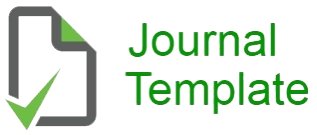PENGARUH LEMBAR KERJA BERBASIS DIFFIT ARTIFICIAL INTELLIGENCE TERHADAP KETERLIBATAN SISWA DALAM PEMBELAJARAN AGAMA ISLAM KELAS VII DI SMP NEGERI 7 SAMBAS TAHUN AJARAN 2024-2025
Keywords:
Diffit Artificial Intelligence-based Worksheets, Student Engagement, Islamic Religious EducationAbstract
This study aims to examine the effect of using artificial intelligence (AI)-based worksheets on student engagement in Islamic Religious Education (PAI) learning among seventh-grade students at SMP Negeri 7 Sambas. The research employed a quantitative approach with a quasi-experimental design, involving two classes: one experimental class using AI-based worksheets and one control class using conventional methods. The research instruments consisted of pre-test, post-test, observation, and a student engagement questionnaire, analyzed using t-tests and PLS-SEM. The findings revealed that before the intervention, student engagement levels were relatively low in both the experimental class (average score 62.8) and the control class (57.7). After the implementation of AI-based worksheets, student engagement in the experimental class increased significantly to an average score of 86.8, while the control class only reached 61.63. The t-test results indicated a significant difference between the two groups. Moreover, the PLS-SEM analysis confirmed the validity and reliability of the instruments and reinforced the positive effect of AI-based worksheets on student engagement. In conclusion, AI-based Diffit worksheets significantly enhanced students’ cognitive, affective, and psychomotor engagement in PAI learning. These findings suggest that integrating AI technology into religious education can serve as an effective strategy to foster active student participation in the digital era.
Downloads
References
Adhawiyah, Rabiatul, Diah Rahayu, and Aulia Suhesty. “The Effect of Academic Resilience and Social Support towards Student Involvement in Online Lecture.” Gadjah Mada Journal of Psychology (GamaJoP) 7, no. 2 (2021): 212. https://doi.org/10.22146/gamajop.68594.
Aguirre-Urreta, Miguel, George Marakas, and Michael Ellis. “Measurement of Composite Reliability in Research Using Partial Least Squares: Some Issues and an Alternative Approach.” ACM SIGMIS Database 44 (November 14, 2013): 11–43. https://doi.org/10.1145/2544415.2544417.
Amora, Johnny T. “Convergent Validity Assessment in PLS-SEM: A Loadings-Driven Approach.” Data Analysis Perspectives Journal 2, no. 1 (2021): 1–6.
Anderson, Lorin W, David R Krathwohl Peter W Airasian, Kathleen A Cruikshank, Richard E Mayer, Paul R Pintrich, James Raths, and Merlin C Wittrock. A Taxonomy for Learning, Teaching, and Assessing: A Revision of Bloom’s Taxonomy of Educational Objectives. Longman. Newyork, 2001. eclass.uoa.gr.
Astin, Alexander W. “Student Involvement: A Developmental Theory for Higher Education.” College Student Development and Academic Life: Psychological, Intellectual, Social and Moral Issues 40, no. July (1984): 518–29.
Ayatillah, M Ishom Fahmi, and Wiwin Luqna Hunaida. “Penggunaan Artificial Intelligence Dalam Pengembangan Perangkat Pembelajaran Pai Di SMP Negeri 22 Kota Surabaya” 3, no. 2 (2024): 86–95. https://doi.org/10.61094/arrusyd.2830-2281.333.
Bloom, Benjamin S. Taxonomy of Educational Objectives: The Classification of Educational Goals. Edited by David McKay Company. Handbook I: Cognitive Domain. Newyork, 1956. https://doi.org/10.1300/J104v03n01_03.
Choo, Serene S.Y., Jerome I. Rotgans, Elaine H.J. Yew, and Henk G. Schmidt. “Effect of Worksheet Scaffolds on Student Learning in Problem-Based Learning.” Advances in Health Sciences Education 16, no. 4 (2011): 517–28. https://doi.org/10.1007/s10459-011-9288-1.
Dale, Edgar. Audio-Visual Methods in Teaching. Newyork: Dryden Press, 1946. ocw.metu.edu.tr.
Deng, QianSong, Yuanjie Li, and Lixin Zheng. “Digital Education Reform for Improving Interaction between Students and Instructors” 10452 (2017): 188. https://doi.org/10.1117/12.2269871.
Fahrudin, Rifqi, Riyadi Sollikhin, and Anis Masruroh. “Inovasi Pembelajaran Pendidikan Agama Islam Melalui Teknologi Artificial Intelligence Untuk Meningkatkan Interaksi Siswa.” Mauriduna: Journal of Islamic Studies 5, no. 1 (2024): 79–91. https://doi.org/10.37274/mauriduna.v5i1.1298.
Fredricks, Jennifer A, Phyllis C Blumenfeld, and Alison H Paris. “School Engagement: Potential of the Concept, State of the Evidence.” Review of Educational Research 74, no. 1 (March 1, 2004): 59–109. https://doi.org/10.3102/00346543074001059.
Hidayat, Luthfi Aulia, Elan Sumarna, and Pandu Hyangsewu. “Inovasi Pembelajaran PAI : Penerapan Kecerdasan Buatan Untuk Meningkatkan Motivasi Siswa.” Journal of Education Research 5, no. 4 (2024): 5632–40.
Humaeroh, Eneng. “Islamic Religious Education Learning and Trends in the Use of Artificial Intelligence.” ASIAN: Indonesian Journal of Learning Development and Innovation 1, no. 1 (2023): 31–35. https://journal.institercom-edu.org/index.php/asian.
Indonesia, Kementerian Agama Republik. Al-Qur’am Dan Terjemahannya. Kementerian Agama. Jakarta: Pencetakan Diponegoro, 2023.
Krafft, P. M., Meg Young, Michael Katell, Jennifer E. Lee, Shankar Narayan, Micah Epstein, Dharma Dailey, et al. “An Action-Oriented AI Policy Toolkit for Technology Audits by Community Advocates and Activists.” FAccT 2021 - Proceedings of the 2021 ACM Conference on Fairness, Accountability, and Transparency, 2021, 772–81. https://doi.org/10.1145/3442188.3445938.
Kurikulum, Pusat, and Badan Penelitian dan Pengembangan. Kurikulum 2004: Standar Kompetensi Mata Pelajaran Pendidikan Agama Islam Sekolah Menengah Pertama Dan Madrasah Tsanawiyah. Standar Kompetensi Perawat Indonesia. Jakarta, 2003.
Liao, Q. Vera, and Jennifer Wortman Vaughan. “AI Transparency in the Age of LLMs: A Human-Centered Research Roadmap.” Harvard Data Science Review, no. Special Issue 5 (2024): 1–33. https://doi.org/10.1162/99608f92.8036d03b.
Lutfiyani, Siti, Putri Yohana Sinuraya, Resti Wicitra Anggraini, Adelia Enov, and Sipa Ulailiah. “Penerapan Teknologi Dalam Peningkatan Motivasi Dan Keterlibatan Siswa Kelas VI SDN Barengkok 1.” Media Penelitian Pendidikan : Jurnal Penelitian Dalam Bidang Pendidikan Dan Pengajaran 17, no. 2 (2023): 227–34. https://doi.org/10.26877/mpp.v17i2.12546.
Machado, Andreia de Bem, and Francisco Fialho. “Interaction and Interactivity Process: Communication in Digital Education.” JINAV: Journal of Information and Visualization 1, no. 2 (2020): 67–73. https://doi.org/10.35877/454ri.jinav254.
Malayu, Owi Ali Nurdin, and Aisahrani Ritonga. “Peran Teknologi Artificial Inttelligence ( AI ) Dalam Pembelajaran Pendidikan Agama Islam.” Maurida: Journal of Islamic Studies 5, no. 1 (2024): 223–32. http://ejournal.arraayah.ac.id.
Nafiati, Dewi Amaliah. “Revisi Taksonomi Bloom: Kognitif, Afektif, Dan Psikomotorik.” Humanika 21, no. 2 (2021): 151–72. https://doi.org/10.21831/hum.v21i2.29252.
Näykki, Piia, Jari Laru, Essi Vuopala, Pirkko Siklander, and Sanna Järvelä. “Affective Learning in Digital Education—Case Studies of Social Networking Systems, Games for Learning, and Digital Fabrication.” Frontiers in Education 4, no. November (2019): 1–14. https://doi.org/10.3389/feduc.2019.00128.
Nurhayati, R, Taufiq Nur, Sudirman P, Nur Adillah, Agustina, and Magfira Urva. “Dinamika Pembelajaran Pendidikan Agama Islam Berbasis Artificial Intelligence (AI).” SENTIKJAR 3 (2024): 1–7. https://doi.org/10.47435/sentikjar.v3i0.3131.
Peraturan Menteri Pendidikan Dan Kebudayaan Nomor 22 Tahun 2016 Tentang Standar Proses Pendidikan Dasar Dan Menengah. Jakarta: Kementerian Pendidikan Dan Kebudayaan, 2016., n.d.
Piaget, Jean. The Construction of Reality in the Child. Newyork: Basic Books, 1954.
Putri, Ciptaning, Jane Savitri, and Meiliani Rohinsa. “Pengaruh Parent Involvement Dan Academic Self-Concept Terhadap School Engagement Dalam Situasi Pandemi Covid-19 Pada Siswa SMK ‘X’ Di Kota Bandung.” Jurnal Penelitian Dan Pengukuran Psikologi: JPPP 12, no. 1 (2023): 44–51. https://doi.org/10.21009/jppp.121.06.
Putri, Hanifa Ashaditya Khamila, and Susanti Prasetyaningrum. “Dampak Efikasi Diri Akademik Terhadap Keterlibatan Siswa Pada Remaja.” Cognicia 11, no. 2 (2023): 99–105. https://doi.org/10.22219/cognicia.v11i2.28486.
Quraish Shihab, M. Tafsir Al-Misbah: Pesan, Kesan, Dan Keserasian Al-Qur’an. Jakarta: Lentera Hati, 2002., n.d.
Rasoolimanesh, S Mostafa. “Discriminant Validity Assessment in PLS-SEM: A Comprehensive Composite-Based Approach.” Data Analysis Perspectives Journal 3, no. 2 (2022): 1–8.
SAMBAS, FAKULTAS TARBIYAH DAN ILMU KEGURUAN INTITUT AGAMA ISLAM SULTAN MUHAMMAD SYAFIUDDIN. Pedoman Penulisan Skripsi. Edited by Suriadi. Sambas: Fakultas Tarbiyah dan Ilmu Keguruan IAIS Sambas, 2017.
Saraswati, Monica Nabila. “Hubungan Antara Keterlibatan Siswa Dengan Kenakalan Remaja Pada Siswa Kelas Xi Di Sma Taruna Nusantara.” Jurnal EMPATI 12, no. 1 (2023): 1–6. https://doi.org/10.14710/empati.2023.28820.
Sinaga, Juni Arsih. “Membangun Lingkungan Belajar Menyenangkan Untuk Mengatasi Kecemasan Matematika Dan Meningkatkan Keterlibatan Siswa Kelas I SD Sekolah XYZ Jakarta.” Jurnal Syntax Admiration 5, no. 2 (2024): 535–47. https://doi.org/10.46799/jsa.v5i2.1039.
Subhaktiyasa, Putu Gede. “PLS-SEM for Multivariate Analysis : A Practical Guide to Educational Research Using SmartPLS” 4, no. 3 (2024).
Surahman, Ence, Adri Satrio, and Heminarto Sofyan. “Kajian Teori Penelitian.” Jurnal Kajian Teknologi Pendidikan 3, no. 1 (2020): 49–58. https://j-innovative.org/index.php/Innovative/article/view/1880.
Triyaningsih, and Findyta Novia Ferosa. “Keterlibatan Siswa Dalam Pembelajaran Online Mata Pelajaran Biologi Pada Masa Pandemi.” Bio-Pedagogi 11, no. 2 (2023): 91. https://doi.org/10.20961/bio-pedagogi.v11i2.51639.
Tu, Tao, Shekoofeh Azizi, Danny Driess, Mike Schaekermann, Mohamed Amin, Pi-Chuan Chang, Andrew Carroll, et al. “Towards Generalist Biomedical AI.” Nejm Ai 1, no. 3 (2024): 1–37. https://doi.org/10.1056/aioa2300138.
Undang-Undang Nomor 20 Tahun 2003 Tentang Sistem Pendidikan Nasional. Jakarta: Sekretariat Negara, 2003, n.d.
Zakirman, Widiasih Widiasih, Rika Aprianti, and Khoirotun Nadiyyah. “The Need for Electronic Games to Support Student Involvement and Concentration in Learning.” Jurnal Pijar Mipa 18, no. 4 (2023): 592–600. https://doi.org/10.29303/jpm.v18i4.5213.










